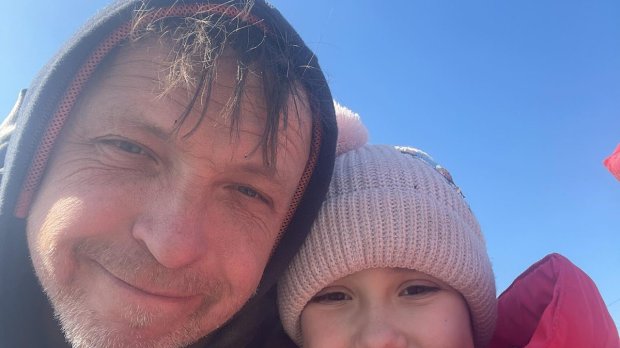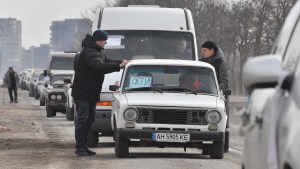Among the many stories of heroism that emerge from the Ukrainian war (and those we will never know), there’s the story of Oleksiy Symonov. He led 117 people on foot to escape from Mariupol alive in the midst of the siege and shelling. He led them for 12 hours and took them to a safer place.
For this reason, he has begun to be called “the Moses of Mariupol.” Instead of through the Egyptian desert, he led his flock along the highways of Ukraine.
Mariupol is now occupied by the Russians. Who knows what would have become of all these people if they had stayed in the city. No place was safe for them anymore, not even shelters, and there was no food.
Symonov recounted this journey at length to Spanish news outlet ABC’s journalist Monica G. Prieto.
Before being nicknamed “Symoses,” 44-year-old Symonov was a organizer, host, and judge of sporting events. At the beginning of the war, he went to a shelter in his neighborhood with his wife and three children, aged 7 to 14. It was a large subway and there were an average of 280 people coming and going, with about 50 children and a similar number of elderly and disabled people. It wouldn’t have been his first choice, but he was trapped. He told the Kharkiv Human rights Protection Group (KHPG) that he didn’t have a car and considered the escape route, plagued with Russian occupiers, too risky.
It was cold, and they had to collect rainwater to drink and make soups or tea infusions. They made fire with logs that the men went to fetch: first they cut them down with a saw they bought, but then they used the tree trunks blown to pieces by the bombs. He told KHPG:
We gathered firewood and water, melted the snow, gathered rainwater, gathered food. It was very important to be communicative, because communication is much more important than money that didn’t matter anymore. There were more than 280 people in the shelter. We helped one another, that’s why we survived.
It was common for artillery, aviation and mortar bombardments to be heard outside. According to what he told the ABC journalist, the shelter was the target of four periods of bombing.
The moment of their escape
He told KHPG:
I have three children and I thought I could not put my children in such danger. We have waited until it got a bit warmer, so that if we go, we would not freeze after the sun sets. Also we have waited for the shelling to shift away from our shelter at least a bit, to make sure we at least would not be hit like everything around while we are escaping.
Symonov held on as long as he could, but the shelling of the Mariupol Theater, which took place on March 16, made Symonov decide to get out of that hell, taking with him as many people as he could.
On the 22nd, without means of transport or supplies, they left Mariupol. They had to take advantage of the fact that the Russians were attacking other neighborhoods. That was the only positive thing they could see, and they had to seize the opportunity because there was no reason to think that there would be a better opportunity if they waited any longer.
The group started with 80 people loaded with bundles made from the bags of what they had in the shelter. They were joined by 37 others and thus formed a long line. The youngest was 5 years old, and the oldest, 70. KHPG asked Symonov what it was like. He replied:
Look, you march vigorously with a backpack surrounded by people and they also walk with backpacks, bags, boxes, with cats, with little children who also hold backpacks and bags. Well, it’s such a big procession. When my friends realized that I’m alive, they wrote: “You are not Symonov, you are Symoses. Bringing people through asphalt deserts.”
Symonov explained to the journalist from ABC how they were able to travel unharmed:
There were so many of us that we were very visible, but at that time the Russian soldiers were pretending to be liberating us and no one shot at us. We started walking without pause, without looking back. We didn’t carry white flags, nor any visible identification, because we believed that could be interpreted as a provocation by either side. We wore orange vests, life-saving vests, so that they would know that we were not military.
In retrospect, the leader assesses for ABC how the escape went and what they saw along the way:
It was very risky because there was shelling, but not close enough to feel at imminent risk.
The streets had been flattened by artillery, air strikes, and mortars. We only saw soldiers as we were leaving the city. Our district was simply flattened, destroyed by artillery.
The group led by Symonov had to get through 17 Russian checkpoints. He says that they were very professional and treated them well, but they were inviting them to get onto transportation that would take them to Russia. Most didn’t want to go. Symonov doesn’t judge the other people who did, though, because he understands that in that situation, what everyone wants is to flee from such great danger. He told KHPG:
Some people went to Rostov, to Russia, because they had relatives or some friends there. Well, everyone has the right to choose. That’s what makes Ukraine different from those who came from Russia. We have a choice. We decide what to do and how to do it. And in all circumstances we remain human.
The 12 hours of escape were moments when everyone gave their best. He explained to ABC:
No one slowed down, not even the children. No one complained about being tired. Sometimes I told them that we could walk more slowly because the explosions sounded far away, but they refused to do it, such was their desire to get away from there and get to safety. No one was afraid to flee, they were more afraid to stay under the bombs.
After 12 hours of walking, exhausted and in very precarious conditions, the escape party reached Komyshuvate, a town west of Mariupol. They were met with a wave of solidarity: the neighbors came to their aid in the best way they could. They gave them a place to sit, food, shelter … They were still in their country at war, but somewhat safer. “The families gave us shelter in Komyshuvate in warm houses. We showered for the first time in a month. What can I say? I have a second family in Komyshuvate now,” he told KHPG.
Symonov says he had trained himself for crisis situations that can occur in his line of work. Some examples from apocalyptic movies also served him well. But the driving force has undoubtedly been his desire to help all these people and get his family to safety.



